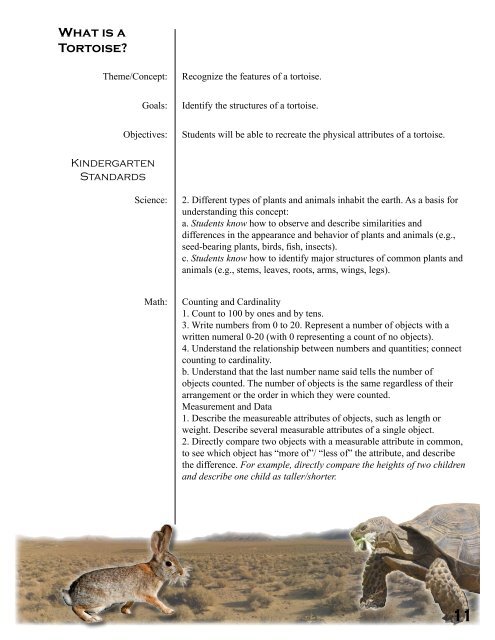K - 2nd Grade - What is a Desert Tortoise?
K - 2nd Grade - What is a Desert Tortoise?
K - 2nd Grade - What is a Desert Tortoise?
Create successful ePaper yourself
Turn your PDF publications into a flip-book with our unique Google optimized e-Paper software.
<strong>What</strong> <strong>is</strong> a<br />
Torto<strong>is</strong>e<br />
Theme/Concept:<br />
Recognize the features of a torto<strong>is</strong>e.<br />
Goals:<br />
Identify the structures of a torto<strong>is</strong>e.<br />
Objectives:<br />
Students will be able to recreate the physical attributes of a torto<strong>is</strong>e.<br />
Kindergarten<br />
Standards<br />
Science:<br />
2. Different types of plants and animals inhabit the earth. As a bas<strong>is</strong> for<br />
understanding th<strong>is</strong> concept:<br />
a. Students know how to observe and describe similarities and<br />
differences in the appearance and behavior of plants and animals (e.g.,<br />
seed-bearing plants, birds, f<strong>is</strong>h, insects).<br />
c. Students know how to identify major structures of common plants and<br />
animals (e.g., stems, leaves, roots, arms, wings, legs).<br />
Math:<br />
Counting and Cardinality<br />
1. Count to 100 by ones and by tens.<br />
3. Write numbers from 0 to 20. Represent a number of objects with a<br />
written numeral 0-20 (with 0 representing a count of no objects).<br />
4. Understand the relationship between numbers and quantities; connect<br />
counting to cardinality.<br />
b. Understand that the last number name said tells the number of<br />
objects counted. The number of objects <strong>is</strong> the same regardless of their<br />
arrangement or the order in which they were counted.<br />
Measurement and Data<br />
1. Describe the measureable attributes of objects, such as length or<br />
weight. Describe several measurable attributes of a single object.<br />
2. Directly compare two objects with a measurable attribute in common,<br />
to see which object has “more of”/ “less of” the attribute, and describe<br />
the difference. For example, directly compare the heights of two children<br />
and describe one child as taller/shorter.<br />
11

















